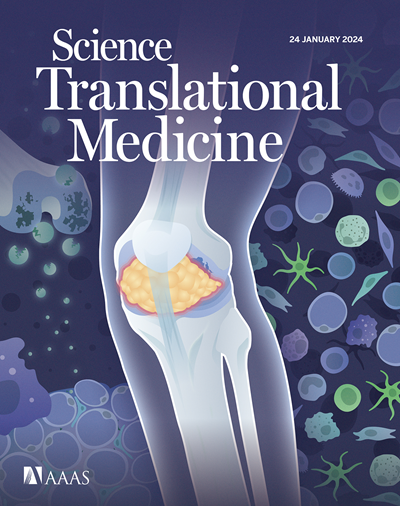Repurposing an epithelial sodium channel inhibitor as a therapy for murine and human skin inflammation
IF 15.8
1区 医学
Q1 CELL BIOLOGY
引用次数: 0
Abstract
Inflammatory skin disease is characterized by a pathologic interplay between skin cells and immunocytes and can result in disfiguring cutaneous lesions and systemic inflammation. Immunosuppression is commonly used to target the inflammatory component; however, these drugs are often expensive and associated with side effects. To identify previously unidentified targets, we carried out a nonbiased informatics screen to identify drug compounds with an inverse transcriptional signature to keratinocyte inflammatory signals. Using psoriasis, a prototypic inflammatory skin disease, as a model, we used pharmacologic, transcriptomic, and proteomic characterization to find that benzamil, the benzyl derivative of the US Food and Drug Administration–approved diuretic amiloride, effectively reversed keratinocyte-driven inflammatory signaling. Through three independent mouse models of skin inflammation (Rac1G12V transgenic mice, topical imiquimod, and human skin xenografts from patients with psoriasis), we found that benzamil disrupted pathogenic interactions between the small GTPase Rac1 and its adaptor NCK1. This reduced STAT3 and NF-κB signaling and downstream cytokine production in keratinocytes. Genetic knockdown of sodium channels or pharmacological inhibition by benzamil prevented excess Rac1-NCK1 binding and limited proinflammatory signaling pathway activation in patient-derived keratinocytes without systemic immunosuppression. Both systemic and topical applications of benzamil were efficacious, suggesting that it may be a potential therapeutic avenue for treating skin inflammation.
重新利用上皮钠通道抑制剂治疗小鼠和人类皮肤炎症
炎症性皮肤病的特点是皮肤细胞和免疫细胞之间的病理相互作用,可导致毁容的皮肤病变和全身炎症。免疫抑制通常用于靶向炎症成分;然而,这些药物往往很昂贵,而且有副作用。为了确定以前未确定的靶点,我们进行了无偏倚信息学筛选,以确定具有角化细胞炎症信号逆转录特征的药物化合物。以牛皮癣(一种典型的炎症性皮肤病)为模型,我们使用药理学、转录组学和蛋白质组学特征来发现苯甲酰胺(美国食品和药物管理局批准的利尿剂阿米洛利的苯基衍生物)有效地逆转了角化细胞驱动的炎症信号。通过三种独立的皮肤炎症小鼠模型(Rac1 G12V转基因小鼠、外用咪喹莫特和牛皮癣患者皮肤异种移植),我们发现苯甲酰胺破坏了小GTPase Rac1与其接头NCK1之间的致病性相互作用。这减少了角化细胞中STAT3和NF-κB信号传导以及下游细胞因子的产生。基因敲除钠通道或苯甲胺的药理抑制可防止患者源性角化细胞中过量的Rac1-NCK1结合和限制促炎信号通路的激活,而不会产生全身免疫抑制。全身和局部应用苯甲胺都是有效的,这表明它可能是治疗皮肤炎症的潜在治疗途径。
本文章由计算机程序翻译,如有差异,请以英文原文为准。
求助全文
约1分钟内获得全文
求助全文
来源期刊

Science Translational Medicine
CELL BIOLOGY-MEDICINE, RESEARCH & EXPERIMENTAL
CiteScore
26.70
自引率
1.20%
发文量
309
审稿时长
1.7 months
期刊介绍:
Science Translational Medicine is an online journal that focuses on publishing research at the intersection of science, engineering, and medicine. The goal of the journal is to promote human health by providing a platform for researchers from various disciplines to communicate their latest advancements in biomedical, translational, and clinical research.
The journal aims to address the slow translation of scientific knowledge into effective treatments and health measures. It publishes articles that fill the knowledge gaps between preclinical research and medical applications, with a focus on accelerating the translation of knowledge into new ways of preventing, diagnosing, and treating human diseases.
The scope of Science Translational Medicine includes various areas such as cardiovascular disease, immunology/vaccines, metabolism/diabetes/obesity, neuroscience/neurology/psychiatry, cancer, infectious diseases, policy, behavior, bioengineering, chemical genomics/drug discovery, imaging, applied physical sciences, medical nanotechnology, drug delivery, biomarkers, gene therapy/regenerative medicine, toxicology and pharmacokinetics, data mining, cell culture, animal and human studies, medical informatics, and other interdisciplinary approaches to medicine.
The target audience of the journal includes researchers and management in academia, government, and the biotechnology and pharmaceutical industries. It is also relevant to physician scientists, regulators, policy makers, investors, business developers, and funding agencies.
 求助内容:
求助内容: 应助结果提醒方式:
应助结果提醒方式:


